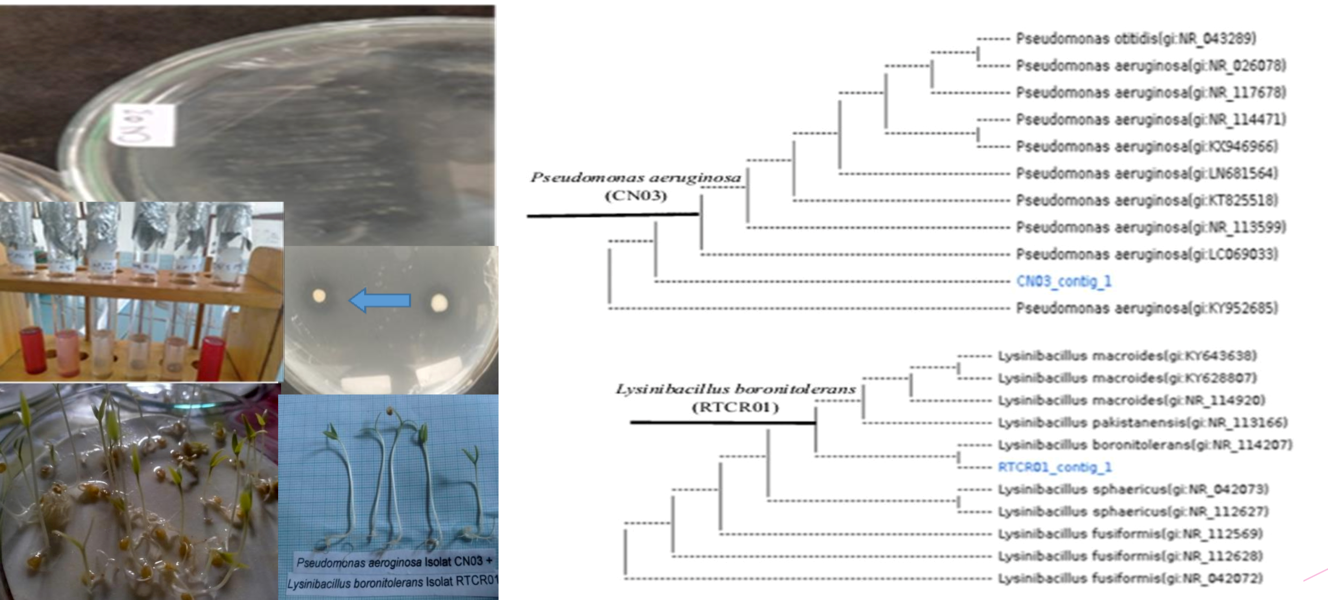Selection of Potential Rhizobacteria As Biological Fertilizer and In Vivo Application against Red Chili Seed Germination In North Central Timor Regency, Indonesia
DOI:
https://doi.org/10.48048/tis.2023.6753Keywords:
Capsicum frutescens, Lysinibacillus boronitolerans, Biofertilizer, Pseudomonas aeruginosa; RhizobacteriaAbstract
North Central Timor (NCT) Regency, located on Timor Island, East Nusa Tenggara Province (NTT) Indonesia, has dry climate conditions with rainfall of 1,500 milli meters (mm) every year. This holds the potential for microbial diversity including rhizobacteria. This research aimed to select and identify potential isolates as biological fertilizers and in vivo application for bird’s eye pepper (Capsicum frutescens) germination. Selection of rhizobacteria from 20 isolates collected by researchers was obtained 5 isolates solubilizer phosphate, 4 isolates fixed nitrogen, and 5 isolates produced Indole Acetic Acid (IAA). Two isolates of CN03 and RTCR01 have potential as biofertilizers. The results of biochemical identification demonstrate that CN03 and RTCR01 isolates ferment glucose, lactose, and sucrose, are positive for citrate and catalase tests, while the molecular identification of 16S rRNA isolates CN03 99 % is similar to Pseudomonas aeruginosa and isolates RTCR01 99 % is similar to Lysinibacillus boritolerans. Meanwhile, the application with the immersion treatment of bacterial isolates on the bird’s eye pepper seed germination results in immersion treatment (K1) of Pseudomonas aeruginosa; (K3) the combination of P. aeruginosa and L. boronitolerans significantly (p > 0.05) affected germination, vigor index, length of root, and growth of sprouts, but treatment (K2) L. boronitolerans is not significantly different (p < 0.05) from the control treatment (KO) using distilled water.
HIGHLIGHTS
- This article reports local rhizobacteria isolates from Timor Island-East Nusa Tenggara, Indonesia, as N-fixers, P-solubilizers, and IAA-producers. These three characters are part of the parameters needed in the utilization of microbes as biofertilizers
- This research is quite simple since the functional characters of isolates were examined qualitatively
- Application of the selected bacteria on bird’s eye pepper (Capsicum frutescens) germination was in preliminary bioassay
- A modern parameter is the identification of selected bacterial isolates by molecular methods based on the 16S rRNA gene sequence
GRAPHICAL ABSTRACT

Downloads
Metrics
References
MR Djuwansah, EP Utomo and TP Sastramihardja. Potensi sumberdaya air propinsi NTT sebagai penunjang pengembangan kawasan cendana. Ber. Biol. 2001; 5, 593-7.
RR Fulthorpe, LFW Roesch, A Riva and EW Triplett. Distantly sampled soils carry few species in common. J. Int. Soc. Microb. Ecol. 2008; 2, 901-10.
A Kielak, AS Pijl, Agata, JAV Veen and GA Kowalchuk. Phylogenetic diversity of acidobacteria in a former agricultural soil. J. Int. Soc. Microb. Ecol. 2009; 3, 378-82.
EE Idriss, O Makarewicz, A Farouk, K Rosner, R Greiner, H Bochow, T Richter and R Borriss. Extracellular phytase activity of bacillus amyloliquefaciens FZB45 contributes to its plant-growth-promoting effect. Microbiology 2002; 148, 2097-109.
RS Pratiwi, TE Susanto, YAK Wardani and A Sutrisno. Enzim kitinase dan aplikasi di bidang industri. Jurnal Pangan dan Agroindustri 2015; 3, 878-87.
BN Aloo, BA Makumba and R Ernest. Plant growth promoting rhizobacterial biofertilizers for sustainable crop production: The past, present, and future. Preprints 2020; 31, 1-31.
Djajadi, R Syaputra and SN Hidayati. Effect of NPK fertilizer, biofertilizer containing N fixer and P solubilizer, and green manure of C. Juncea on nutrients uptake and growth of sugarcane. IOP Conf. Ser. Earth Environ. Sci. 2020; 418, 3-10.
A Lerner, Y Herschkovitz, E Baudoin, S Nazaret, YM Loccoz, Y Okon and E Jurkevitch. Effect of azospirillum brasilense inoculation on rhizobacterial communities analyzed by denaturing gradient gel electrophoresis and automated ribosomal intergenic spacer analysis. Soil Biol. Biochem. 2006; 38, 1212-18.
P Parasuraman, J Rajkumari, S Pattnaik and S Busi. Biocontrol potential against fusarium oxysporum F. Sp. lycopersici and alternaria solani and tomato plant growth due to plant growth-promoting rhizobacteria. Int. J. Veg. Sci. 2017; 23, 294-303.
CS Nautiyal. An efficient microbiological growth medium for screening phosphate solubilizing microorganisms. FEMS Microbiol. Lett. 1999; 170, 265-70.
G Fallo, NR Mubarik and Triadiati. Potency of auxin producing and phosphate solubilizing bacteria from dryland in rice paddy field. J. Microb. 2015; 10, 246-59.
Huslina, Feizia and D Harahap. Isolasi bakteri pengikat nitrogen dengan menggunakan media jensen. Jurnal Agrotek Ummat 2019; 6, 91.
Nusyirwani and CA Kathy. Isolasi dan karakterisasi bakteri hidrokarbonoklastik dari perairan dumai dengan sekuen 16S RDNA. J. Mar. Sci. 2007; 12, 12-7.
JR Marchesi, T Sato, AJ Weigmant, TA Martin, JC Fry, SJ Hiom, D Dymock and WG Wade. Design and evaluation of useful bacterium-specific PCR primers that amplify genes coding for bacterial 16S RRNA. Appl. Environ. Microb. 1998; 64, 795-9.
F Huslina and D Harahap. Isolasi bakteri pengikat nitrogen dengan menggunakan media jensen. Agrotek Ummat 2019; 6, 91-3.
GAK Sutariati, W Widodo, Sudarsono and S Ilyas. Effects of plant growth promoting rhizobacteria on seed germination and seedling growth of hot pepper. Indones. J. 2006; 54, 46-54.
A Agustian, N Nuriyani, L Maira and O Emalinda. Rhizobakteria penghasil fitohormon IAA pada rhizosfir tumbuhan semak karamunting, titonia, dan tanaman pangan. Jurnal Solum. 2010; 7, 49-60.
Ahsan, Nusrat, and M Shimizu. Lysinibacillus species: Their potential as effective bioremediation, biostimulant, and biocontrol agents. Rev. Agric. Sci. 2021; 9, 103-16.
HN Jinal, K Gopi, P Prittest, VP Kartik and N Amaresen. Phytoextraction of iron from contaminated soils by inoculation of iron-tolerant plant growth-promoting bacteria in brassica juncea L. czern. Environ. Sci. Pollut. Res. 2019; 26, 32815-23.
I Ahmed, A Yokota, A Yamazoe and T Fujiwara. Proposal of lysinibacillus boronitolerans gen. Nov. Sp. Nov., and transfer of bacillus fusiformis to lysinibacillus fusiformis comb. Nov. and Bacillus sphaericus to lysinibacillus sphaericus comb. Nov. Int. J. Syst. Evol. Microbiol. 2007; 57, 1117-25.
A Sembiring and NL Sumanto. Isolasi bakteri penghasil asam indol asetat (AIA) dan pengaruhnya terhadap viabilitas benih cabai merah. Jurnal Agrotek Ummat 2021; 8, 26-31.
CL Patten and BR Glick. Role of pseudomonas putida indoleacetic acid in development of the host plant root system. Appl. Environ. Microb. 2022; 68, 3795-801.

Downloads
Published
How to Cite
Issue
Section
License
Copyright (c) 2023 Walailak University

This work is licensed under a Creative Commons Attribution-NonCommercial-NoDerivatives 4.0 International License.






